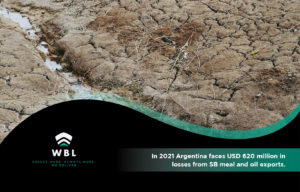Due to the River Parana’s downspout, so far in 2021 Argentina faces USD 620 million in losses from SB meal and oil exports.
The low level of the Paraná River restricts loading possibilities in the greater Rosario metropolitan area, forcing reductions in export prices of the main by-products of the soy complex, and generating significant losses. Maize also suffering, supporting cargos from southern ports.
The downspout of the Paraná River has had a particularly strong impact on Argentine exports. This lower height in the Timbues-Atlantic section limits cargo capacity for vessels navigating Paraná waters, in addition to forcing cargos to be diverted to other ports.
The higher logistics costs to export from Paraná ports impacts on the export prices from the Greater Rosario area, widening the spread with the Brazilian origin. This way, the gap between FOB Paranaguá and FOB Upriver/Rosario for SB meal is currently at its worst FOB price differential since 2013. To find an even worse differential for meal, we’d have to go back to the 2003-2005 period. The situation is even more unfavorable for Argentine SBO, with a price differential that hasn’t been seen since 2008.
With more than 25 million tons of soy byproducts already shipped out so far, we estimate a loss of more than USD 620 million for these Upriver shipments this year.
Given these conditions, SB meal and oil exports are currently being shipped with prices that limit the influx of dollars, due to the lesser competitiveness of Argentine origin and the severe difficulties in port logistics due to the low flow from the Paraná-Paraguay Waterway near the Rosario area.
Losses have been accounted since the beginning of the year, yet the low river level has been dragging on since September 2019, given the drop in the water level below the minimum of 2.47 meters that must be registered at Rosario for the finalized concession to force Hidrovía SA to guarantee the 34 feet of draft. Only February 2021 showed an average height higher than this referential minimum in the last two years. Currently, with the height of the Paraná at negative levels in Rosario Port hydrometer and a continuation of the decreasing trend, no scenario suggests a recovery of the water level, at least until December of this year, according to the Argentinian National Institute of Water (INA).

Concerning SB meal, the losses are particularly important given a differential that over the years has generally been on the positive side, that is, with Upriver FOB prices above those of Paranagua. The negative differential impacts more when SBM exports rise. After the minimum of 17.8 Mil MT in the January-August 2020 period, exports have recovered and already exceed 20.2 Mil MT in the same period.
Regarding SB oil, the downspout losses have been even more critical. Although the Upriver-Paranagua price differential has generally been found favoring the Brazilian ports, the price divergence has sharpened in recent months. Furthermore, the progressive global economic recovery has fueled the demand for SB oil with special emphasis, which took shipments from 3.7 to 4.2 Mil MT, considering the first eight months of the year.
More differences that cause worries.
The drop has not only strongly affected export prices but has also impacted on domestic grain prices. The case of maize is eloquent, in the midst of the main harvest, the Parana downspout has restricted the possibility of loading the corn from Upriver.
Consequently, the loading of maize from Bahía Blanca has broken historical records. This has resulted in price increases in the south of Buenos Aires province, while relative stability has been observed in Rosario city prices. While in September an average of 230 USD/MT of maize has been paid ex Bahía Blanca, in Rosario the price fluctuates around 192 USD/MT, which poses a differential of around 38 USD/MT. On the other hand, the picture was completely different in September of last year when maize shipped from Bahía Blanca averaged 156 USD/TM and that of Rosario 158 USD/MT, a difference of 2 USD/MT in favor of Upriver ports.
Source: https://bcr.com.ar/
Photo: REUTERS/Stringer
For more info visit
https://www.linkedin.com/company/wbl-shipping-agency/
